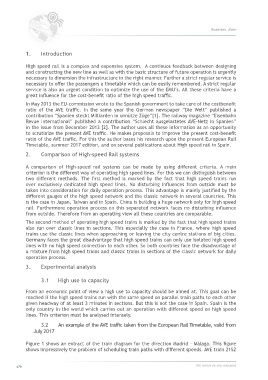Page 480 - 360.revista de Alta Velocidad - Nº 6
P. 480
Andersen, Sven
1. Introduction
High speed rail is a complex and expensive system. A continuos feedback between designing
and constructing the new line as well as with the basic structure of future operation is urgently
necessary to dimension the infrastructure in the right manner. Further a strict regular service is
necessary to offer the passengers a timetable which can be easily remembered. A strict regular
service is also an urgent condition to optimize the use of the EMU’s. All these criteria have a
great influence for the cost-benefit ratio of the high speed traffic.
In May 2013 the EU-commission wrote to the Spanish government to take care of the costbenefit
ratio of the AVE traffic. In the same year the German newspaper “Die Welt” published a
contribution “Spanien steckt Milliarden in unnütze Züge”[1]. The railway magazine “Eisenbahn
Revue International” published a contribution “Schlecht ausgelastetes AVE-Netz in Spanien”
in the issue from December 2013 [2]. The author uses all these information as an opportunity
to scrutinize the present AVE traffic. He makes proposals to improve the present cost-benefit
ratio of the AVE traffic. For this the author bases his research upon the present European Rail
Timetable, summer 2017 edition, and on several publications about High speed rail in Spain.
2. Comparison of High-speed Rail systems
A comparison of High-speed rail systems can be made by using different criteria. A main
criterion is the different way of operating high speed lines. For this we can distinguish between
two different methods. The first method is marked by the fact that high speed trains run
over exclusively dedicated high speed lines. No disturbing influences from outside must be
taken into consideration for daily operation process. This advantage is mainly justified by the
different gauges of the high speed network and the classic network in several countries. This
is the case in Japan, Taiwan and in Spain. China is building a huge network only for high speed
rail. Furthermore operation process on this separated network faces no disturbing influence
from outside. Therefore from an operating view all these countries are comparable.
The second method of operating high speed trains is marked by the fact that high speed trains
also run over classic lines in sections. This especially the case in France, where high speed
trains use the classic lines when approaching or leaving the city centre stations of big cities.
Germany faces the great disadvantage that high speed trains can only use isolated high speed
lines with no high speed connection to each other. So both countries face the disadvantage of
a mixture from high speed trains and classic trains in sections of the classic network for daily
operation process.
3. Experimental analysis
3.1 High use to capacity
From an economic point of view a high use to capacity should be aimed at. This goal can be
reached if the high speed trains run with the same speed on parallel train paths to each other
given headway of at least 3 minutes in sections. But this is not the case in Spain. Spain is the
only country in the world which carries out an operation with different speed on high speed
lines. This criterion must be analysed intensely.
3.2 An example of the AVE traffic taken from the European Rail Timetable, valid from
July 2017
Figure 1 shows an extract of the train diagram for the direction Madrid - Málaga. This figure
shows impressively the problem of scheduling train paths with different speeds. AVE train 2152
478 360.revista de alta velocidad

